Children and Urinary Infections

Although youngsters do not develop as many urinary tract infections (UTIs) as adults, the condition is not uncommon in children. An estimated 3 percent of girls and 1 percent of boys have had a UTI by age 11. Some researchers believe these estimates are low because many cases of UTIs go undetected. Recognizing and promptly treating a child's UTI is essential because, if left untreated, the infection can lead to serious kidney problems.
Here is how a UTI develops: To produce urine, the kidneys filter and remove waste and water from blood. The urine travels from the kidneys down two narrow tubes called the ureters and is stored in the bladder. When the bladder empties, urine flows out of the body through the urethra, a tube at the bottom of the bladder. The opening of the urethra is at the end of the penis in boys and in the front of the vagina in girls. Although normal urine contains no germs, bacteria may enter the urinary tract from the skin around the rectum and the genitals by traveling up the urethra into the bladder. When this occurs, the bacteria can infect and irritate the bladder. If the bacteria travel further up through the ureters to the kidneys, a kidney infection can develop. Kidney infections are usually accompanied by pain and fever and are considered much more serious than a simple bladder infection (cystitis).
In infants and toddlers, the signs of a UTI may not be obvious. In older children, UTI symptoms typically include frequent urination, an urge to urinate and burning with urination. Other symptoms that may be present include fever, irritability, loss of appetite, nausea and vomiting. If a child has a high temperature and appears sick for more than a day without signs of a runny nose or other obvious cause for discomfort, he or she may need to be checked for a UTI.
Some children, most frequently girls, develop UTIs simply because they are prone to them, the same way that certain children are more susceptible to coughs, colds or ear infections. In other children, UTIs develop because of an abnormal urinary tract condition, such as vesicoureteral reflux, in which urine flows backward from the bladder up the ureters to the kidneys or urinary obstruction, in which urine flow is blocked at sites along the urinary tract. Repeated infections in abnormal urinary tracts may cause kidney damage, especially in young children. Kidney damage may include kidney scars, poor kidney growth, poor kidney function and high blood pressure. When a baby develops a UTI, or when a young girl is diagnosed with recurrent urinary tract infections, additional tests are often recommended to rule out urinary tract abnormalities.
What to Do
What to Do
The only way to find out for certain if a child has a urinary tract infection is by consulting a health care provider. Some of the child's urine will be collected and examined under a microscope, as well as cultured, to determine if he or she has an infection. Many children who develop urinary tract infections have normal kidneys and bladders.
Children who have an abnormality, however, need it diagnosed as early as possible to protect their kidneys against damage.
Use Medicine Effectively
Use Medicine Effectively
Urinary tract infections are treated with antibiotics. The type of antibiotic and length of treatment depends on the severity and location of the infection. After a few doses of the antibiotic, a child may improve, but it often takes several days for the infection to completely clear and for all symptoms to fade. Medications should not be stopped even if the symptoms subside. Infections may return, and failure to complete treatment may result in the development of antibiotic-resistant bacteria.
See a doctors if presence of the following symptoms:
See a doctors if presence of the following symptoms:
- Low-grade fever
- Irritability
- Frequent urination
- Pain or burning during urination
- Strong odor to urine
- Cloudy or blood-tinged urine
- Pain in abdomen
- High fever, back pain, and vomiting
01-22-07 Montreal Children's Hospital


